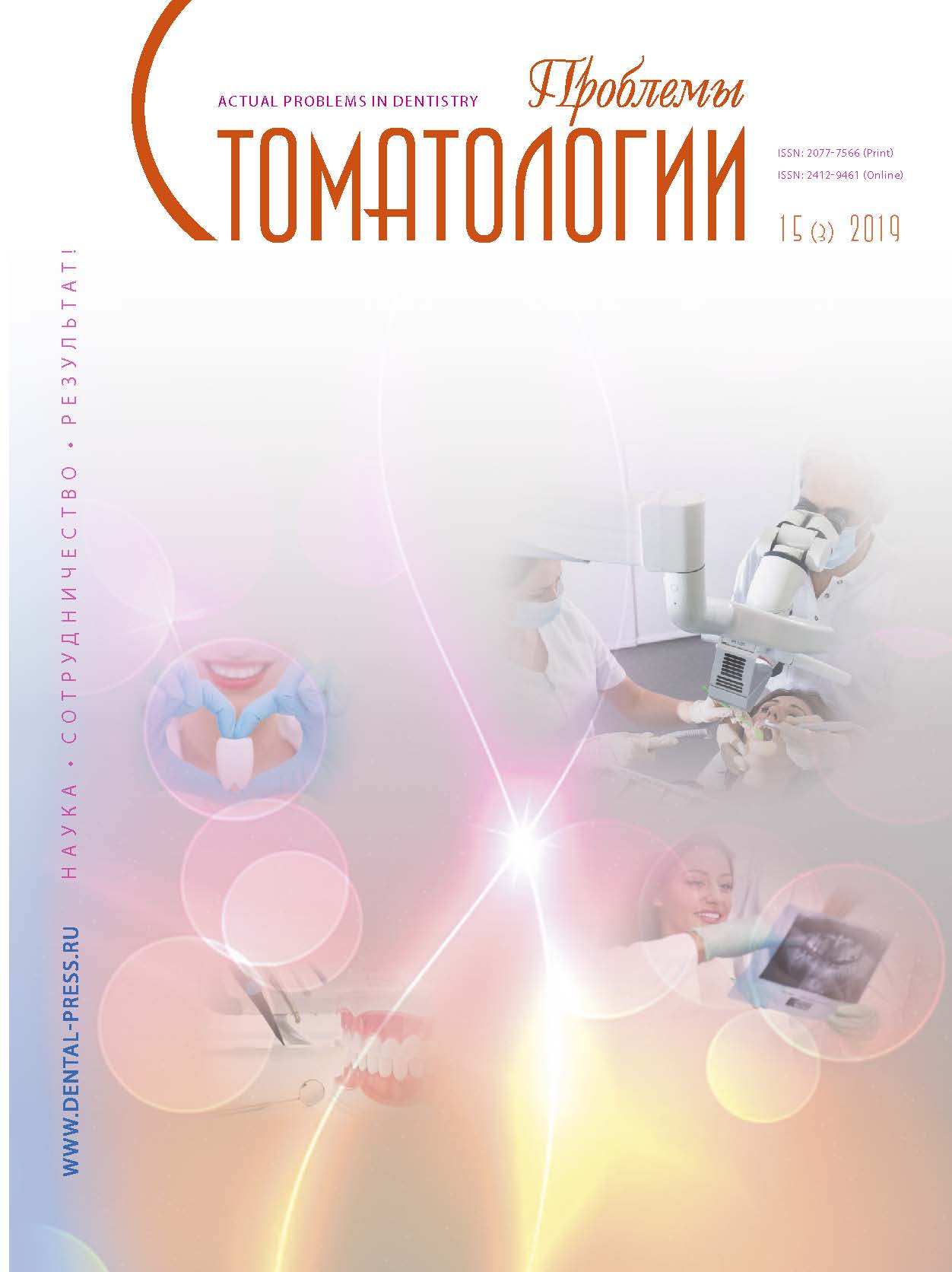Ekaterinburg, Ekaterinburg, Russian Federation
Yekaterinburg, Ekaterinburg, Russian Federation
Ekaterinburg, Russian Federation
Ekaterinburg, Ekaterinburg, Russian Federation
Moskva, Moscow, Russian Federation
Ekaterinburg, Ekaterinburg, Russian Federation
Ekaterinburg, Ekaterinburg, Russian Federation
Ekaterinburg, Ekaterinburg, Russian Federation
Subject. The health status of children and adolescents is one of the most acute medical and social problems. It is known, that with dental diseases, changes occur not only in the immunological profile of the oral fluid, but also in morphology of the oral tissues. New approaches to the traditional cytological study of buccal epithelium such as analysis of the cytogram with the isolation of various types of cells, as well as the detection of cytological abnormalities of cells, allows us to evaluate the reactivity of the oral mucosa in pathological processes. According to WHO recommendations (2013), groups of children 5-6, 12, 15 years of age are the global indicator age groups for monitoring disease trends and comparisons on an international scale. The objective of the study is to assess the health status of children age 5-6, 12, 15 with non-invasive methods. It is based on the results of a clinical and laboratory examination of 179 children, attending organized children's groups. Children underwent a comprehensive dental examination, which included a questionnaire according to the WHO method, an external examination of the maxillofacial region, an examination of the oral cavity, identification of pathology of hard tooth tissues. Methodology. We studied the change in the dental status of patients, indicators of oral fluid and basal epithelium with age, in order to prognostically use non-invasive assessment methods in a comprehensive health examination, planning and evaluating the effectiveness of prevention programs. Results. It was noted that the dental health status of children 5-6, 12, 15 years old can be assessed as satisfactory, while dental, laboratory and cytological health indicators worsen with age. Non-invasive methods for assessing the dental status of patients can be used in a comprehensive examination of children's health, planning and evaluating the effectiveness of prevention programs.
dental status, oral fluid, buccal epithelium, examination of children, non-invasive, DMF index, periodontal disease, pediatric dentistry
1. Bazarny, V. V., Polushina, L. G., Vanevskaya, E. A. (2014). Immunologicheskiy analiz rotovoy zhidkosti kak potentsial'nyy diagnosticheskiy instrument [Immunological analysis of oral fluid as a potential diagnostic tool]. Rossiyskiy immunologicheskiy zhurnal [Russian Immunological Journal], 8 (17), 3, 769-771. (In Russ.)
2. Bazarny, V. V., Polushina, L. G., Svetlakova, E. N., Mandra, Yu. V., Tsvirenko, S. V. (2017). Novyye vozmozhnosti laboratornoy immunodiagnostiki khronicheskogo parodontita [New possibilities of laboratory immunodiagnosis of chronic periodontitis]. Laboratornaya sluzhba [Laboratory service], 3, 34. (In Russ.)
3. Ermukhanova, G. T., Onaybekova, N. M., Leus, P. A., Kiselnikova, L. P. (2017). Korrelyatsionnaya zavisimost' kariyesa zubov i indikatorov riska u podrostkov Kazakhstana, Belarusi i Rossii [The correlation dependence of dental caries and risk indicators in adolescents in Kazakhstan, Belarus and Russia]. Vestnik KazNMU [Vestnik KazNMU], 4, 135-141. (In Russ.)
4. Ioshchenko, E. S., Brusnitsyna, E. V., Zakirov, T. V., Ozhgikhina, N. V., Vorozhtsova, L. I. (2017). Analiz osnovnoy stomatologicheskoy zabolevayemosti detskogo naseleniya g. Yekaterinburga [Analysis of the main dental morbidity in the children of the city of Yekaterinburg]. Problemy stomatologii [Problems of Dentistry], 1, 110-113. (In Russ.) doihttps://doi.org/10.18481/2077-7566-2017-13-1-110-113
5. Mandra, Yu. V., Bazarny, V. V., Chupakhin, O. N., Khonina, T. G., Sementsova, E. A., Svetlakova, E. N., Kotikova, A. Yu., Legkikh, A. V., Polushina, L. G., Teslenko,A. Yu. (2017). Kliniko-morfologicheskaya otsenka effektivnosti primeneniya innovatsionnoy lechebno-profilakticheskoy zubnoy pasty v kompleksnom lechenii patsiyentov molodogo vozrasta s osnovnymi stomatologicheskimi zabolevaniyami [Clinical and morphological evaluation of the effectiveness of the use of innovative therapeutic and preventive toothpaste in the complex treatment of young patients with major dental diseases]. Problemy stomatologii [Problems of Dentistry], 13 (3), 29-35. (In Russ.)
6. Sementsova, E. A., Svetlakova, E. N., Polushina, L. G., Mandra, Yu. V., Bazarny, V. V. (2018). Diagnostika parodontita: nuzhny li innovatsionnyye podkhody? [Diagnosis of periodontitis: are innovative approaches needed?]. Mezhdunarodnyy kongress «Stomatologiya Bol'shogo Urala» 29 noyabrya - 1 dekabrya 2017 goda [International Congress "Dentistry of the Big Urals" November 29 - December 1, 2017], Youth Scientific School on Fundamental Dentistry : Publishing House TIRAZH, 117-119. (In Russ.)
7. Balaji, A., Chandrasekaran, S. C., Subramanium, D., Fernz, A. B. (2017). Salivary Interleukin-6 -A pioneering marker for correlating diabetes and chronic periodontitis: Acomparative study. Indian J Dent Res, 28 (2), 133-137.
8. Benvindo-Souza, M., Assis, R. A., Oliveira, E. A. S., Borges, R. E., Santos, L. R. S. (2017). The micronucleus test for the oral mucosa: global trends and new questions. Environ Sci Pollut Res Int, 24 (36), 27724-27730.
9. Bolerázska, B., Mareková, M., Markovská, N. (2016). Trends in Laboratory Diagnostic Methods in Periodontology. Acta Medica (Hradec Kralove), 59, 1, 3-9.
10. Chaffee, B., Benjamin, W., John, D. B. et al. (2017). Pediatric Caries Risk Assessment as a Predictor of Caries Outcomes. Pediatric Dentistry, 39 (3), 219-232.
11. Corrado, C., Riviello, R., Wilson, K. et al. (2017). Building work- force capacity abroad while strengthening global health programs at home: participation of seven Harvard-affiliated institutions in a health professional training initiative in Rwanda. Acad Med, 92, 649-658. doi:https://doi.org/10.1080/16549716.2018.1477249
12. Davies, G. M., Robinson, R., Neville, J., Burnside, G. (2014). Investigation of bias related to non-return of consent for a dental epidemiological survey of caries among five year olds. Community Dental Health, 31, 21-26.
13. Davies, G. M., Neville, J., Jones, K., White, S. (2017). Why are caries levels reducing in fiveyear-olds in England? British Dental Journal, 223, 1-5.
14. Fleming, E., Afful, J. (2018). Prevalence of total and untreated dental caries among youth: United States, 2015-2016. NCHS Data Brief, 307.
15. Gross, A. J., Paskett, K. T., Cheever, V. J., Lipsky, M. S. (2017). Periodontitis: a global disease and the primary care provider’s role. Postgrad Med J, 93 (1103), 560-565.
16. Jardim, J. J., Alves, L. S., Maltz, M. (2009). The history and global market of oral home-care products. Brazilian oral research, 23, 17-22.
17. Javaid, M. A., Ahmed, A. S., Durand, R., Tran, S. D. (2016). Saliva as a diagnostic tool for oral and systemic diseases. J Oral BiolCraniofac Res, 6 (1), 66-75.
18. Kim, J. M., Choi, J. S., Choi, Y. H., Kim, H. E. (2018). Simplified Prediction Model for Accurate Assessment of Dental Caries Risk among Participants Aged 10-18 Years. Tohoku J Exp Med, 246 (2), 81-86. doihttps://doi.org/10.1620/tjem.246.81
19. Leão, M. M., Garbin, C. A. S., Moimaz, S. A. S., Rovida, T. A. S. (2015). Oral health and quality of life: an epidemiological survey of adolescents from settlement in Pontal do Paranapanema. SP, Brazil. Ciência & Saúde Ciênc. saúde coletiva, 20 (11), 3365-3374. doi: 10. 1590/1413-812320152011.00632015
20. (2017). Maryland Department of Health/ Oral Health Survey of Maryland School Children, 2015-2016. Baltimore, MD : Office of Oral Health, Prevention and Health Promotion Administration.
21. Morgan, J. P., Isyagi, M., Ntaganira, J. et al. (2018). Building oral health research infrastructure: the first national oral health survey of Rwanda. Global Health Action, 11, 1. doi :https://doi.org/10.1080/16549716.2018.1477249
22. Renaud-Vilmer, C., Cavelier-Balloy, B. (2017). Precancerous lesions of the buccal epithelium. Ann DermatolVenereol, 144 (2), 100-108.
23. Shashikala, R., Indira, A. P., Manjunath, G. S., Arathi, K., Akshatha, B. K. (2015). Role of micronucleus in oral exfoliative cytology. J Pharm Bioallied Sci, 7, 2, 409-413.
24. Sidon, J., Kafero-Babumba, C., Clerehugh, V., Tugnait, A. (2018). Paediatric periodontal screening methods in undergraduate dental schools. British Dental Journal, 225, 1073-1077.
25. Stenhouse, L., Green, D., Laverty, D., Dietrich, T. (2017). Global epidemiology of dental caries and severe periodontitis - a comprehensive review. J Clin Periodontol, 44 (18), 94-105. doi:https://doi.org/10.1111/jcpe.12677.
26. Suk, Ji., Youngnim, C. (2015). Point-of-care diagnosis of periodontitis using saliva: technically feasible but still a challenge. Front Cell Infect Microbiol, 3, 5, 65.
27. Vagdouti, T., Tsilingaridis, G. (2018). Periodontal Diseases in Children and Adolescents Affected by Systemic Disorders - A Literature Review. Int J Oral Dent Health, 4 (1), 055. doi:https://doi.org/10.23937/2469-5734/1510055
28. (2013). World Health Organization. Oral Health Surveys Basic Methods, 5, WHO Geneva, 125.




















